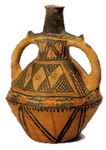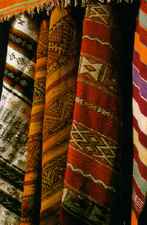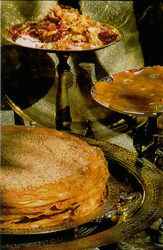A Culture of Eating, Drinking, and Being Hospitable HISTORY AND INFLUENCES Moroccan cuisine is considered one of the most important cuisines
Morocco's reigning monarch, King Hassan II, likens his country to a desert palm: "rooted in Africa, watered by Islam and rustled by the winds of Europe." A poetic description for a place which can appear mystical, magical and foreboding all at once.
 The Phoenicians, merchants from North Africa, were the first to establish a series of trading ports along the coast of Morocco nearly three thousand years ago. Along with the increased trade, the Phoenicians brought with them new skills for the Berbers such as masonry, weaving and iron and metalwork. A period of Roman rule followed, leading to the Arab conquest in the 7th century which brought Islam to the people of Morocco. The Arabs ultimately left but the message and traditions of Islam held firm with the fiercely independent Moroccans. The city of Fez, the country's first royal capital, was founded in 799 AD and quickly became the center of cultural, economic and political life. A succession of tribal dynasties proceeded to rule Morocco, culminating with the Alaouites, Arab sultans who seized power in 1668 and hold it to this day.
The Phoenicians, merchants from North Africa, were the first to establish a series of trading ports along the coast of Morocco nearly three thousand years ago. Along with the increased trade, the Phoenicians brought with them new skills for the Berbers such as masonry, weaving and iron and metalwork. A period of Roman rule followed, leading to the Arab conquest in the 7th century which brought Islam to the people of Morocco. The Arabs ultimately left but the message and traditions of Islam held firm with the fiercely independent Moroccans. The city of Fez, the country's first royal capital, was founded in 799 AD and quickly became the center of cultural, economic and political life. A succession of tribal dynasties proceeded to rule Morocco, culminating with the Alaouites, Arab sultans who seized power in 1668 and hold it to this day. Despite a reigning monarchy, the Europeans vied for control of Morocco throughout the 1800s, with the French finally prevailing as signaled by the Treaty of Fez in 1912. This document declared Morocco to be both a French and Spanish protectorate, influences which remain strong in the country. The second world war muddied the waters of leadership anew, with the Moroccans finally regaining their independence in 1956. The ruling sultan took to calling himself King Mohammed V in keeping with a new constitutional monarchy. His son, King Hassan II, assumed the throne in 1961.
Despite a reigning monarchy, the Europeans vied for control of Morocco throughout the 1800s, with the French finally prevailing as signaled by the Treaty of Fez in 1912. This document declared Morocco to be both a French and Spanish protectorate, influences which remain strong in the country. The second world war muddied the waters of leadership anew, with the Moroccans finally regaining their independence in 1956. The ruling sultan took to calling himself King Mohammed V in keeping with a new constitutional monarchy. His son, King Hassan II, assumed the throne in 1961. The foods of Morocco take great advantage of the natural bounty of a country where eating is both a practical and social ritual. The cooks in the kitchens of the four royal cities (Fez, Meknes, Marrakech and Rabat) helped to refine Moroccan cuisine and create the basis for what we know as Moroccan cuisine today. The midday meal is the main meal, except during the holy month of Ramadan, and abundant servings are the norm. The meal usually begins with a series of hot and cold salads which are followed by a tagine, or stew. The heartiest plate, often a lamb or chicken dish, is next, followed by a heaping plate of couscous topped with meats and vegetables. A soothing cup of sweet mint tea is the grace note to this repast. It is not uncommon for Moroccans to eat using the first three fingers of a hand, and to use bread as a "utensil."
The foods of Morocco take great advantage of the natural bounty of a country where eating is both a practical and social ritual. The cooks in the kitchens of the four royal cities (Fez, Meknes, Marrakech and Rabat) helped to refine Moroccan cuisine and create the basis for what we know as Moroccan cuisine today. The midday meal is the main meal, except during the holy month of Ramadan, and abundant servings are the norm. The meal usually begins with a series of hot and cold salads which are followed by a tagine, or stew. The heartiest plate, often a lamb or chicken dish, is next, followed by a heaping plate of couscous topped with meats and vegetables. A soothing cup of sweet mint tea is the grace note to this repast. It is not uncommon for Moroccans to eat using the first three fingers of a hand, and to use bread as a "utensil." The strong Arab influence found in two of the royal cities, Fez and Marrakech, contributed greatly to Moroccan cuisine, as did the Andalusian sensibilities of Tetuan and the Jewish traditions from the coastal city of Essaouira. Aspects of all of these cultures can be found in four of the best-loved Moroccan dishes: couscous, plumped semolina grains which are served with a variety of toppings; bisteeya, a delectable three-layer pie which is both savory and sweet and wrapped in the thinnest of pastry; mechoui, tender roasted lamb; and djej emshmel, succulent roasted chicken cooked with olives and lemon.
The strong Arab influence found in two of the royal cities, Fez and Marrakech, contributed greatly to Moroccan cuisine, as did the Andalusian sensibilities of Tetuan and the Jewish traditions from the coastal city of Essaouira. Aspects of all of these cultures can be found in four of the best-loved Moroccan dishes: couscous, plumped semolina grains which are served with a variety of toppings; bisteeya, a delectable three-layer pie which is both savory and sweet and wrapped in the thinnest of pastry; mechoui, tender roasted lamb; and djej emshmel, succulent roasted chicken cooked with olives and lemon.
morocco culture,moroccan food,morocco food,moroccan cuisine,morocco beaches,moroccan meal,beaches in morocco,moroccan culture,hercules cave,hercules cave morocco
Morocco's reigning monarch, King Hassan II, likens his country to a desert palm: "rooted in Africa, watered by Islam and rustled by the winds of Europe." A poetic description for a place which can appear mystical, magical and foreboding all at once.
Situated on the northwest coast of Africa, Morocco is one of three countries which make up the maghreb("furthest west"), the other two being Algeria and Tunisia. The Atlantic Ocean is to the west, while the calm waters of the Mediterranean are due north and the harsher sands of the Sahara are to the south. Snaking through the center of the country are a series of mountain ranges, beginning with the Rif mountains in the north and continuing with the Middle Atlas, High Atlas and Anti-Atlas ranges, which nearly split the country in half along a vertical axis. It is these mountainous areas which are heavily populated by the Berbers, the indigenous people of Morocco who still comprise 80% of the population. The Berbers are not ethnically Arabs, but they are Islamic.
 The Phoenicians, merchants from North Africa, were the first to establish a series of trading ports along the coast of Morocco nearly three thousand years ago. Along with the increased trade, the Phoenicians brought with them new skills for the Berbers such as masonry, weaving and iron and metalwork. A period of Roman rule followed, leading to the Arab conquest in the 7th century which brought Islam to the people of Morocco. The Arabs ultimately left but the message and traditions of Islam held firm with the fiercely independent Moroccans. The city of Fez, the country's first royal capital, was founded in 799 AD and quickly became the center of cultural, economic and political life. A succession of tribal dynasties proceeded to rule Morocco, culminating with the Alaouites, Arab sultans who seized power in 1668 and hold it to this day.
The Phoenicians, merchants from North Africa, were the first to establish a series of trading ports along the coast of Morocco nearly three thousand years ago. Along with the increased trade, the Phoenicians brought with them new skills for the Berbers such as masonry, weaving and iron and metalwork. A period of Roman rule followed, leading to the Arab conquest in the 7th century which brought Islam to the people of Morocco. The Arabs ultimately left but the message and traditions of Islam held firm with the fiercely independent Moroccans. The city of Fez, the country's first royal capital, was founded in 799 AD and quickly became the center of cultural, economic and political life. A succession of tribal dynasties proceeded to rule Morocco, culminating with the Alaouites, Arab sultans who seized power in 1668 and hold it to this day. Despite a reigning monarchy, the Europeans vied for control of Morocco throughout the 1800s, with the French finally prevailing as signaled by the Treaty of Fez in 1912. This document declared Morocco to be both a French and Spanish protectorate, influences which remain strong in the country. The second world war muddied the waters of leadership anew, with the Moroccans finally regaining their independence in 1956. The ruling sultan took to calling himself King Mohammed V in keeping with a new constitutional monarchy. His son, King Hassan II, assumed the throne in 1961.
Despite a reigning monarchy, the Europeans vied for control of Morocco throughout the 1800s, with the French finally prevailing as signaled by the Treaty of Fez in 1912. This document declared Morocco to be both a French and Spanish protectorate, influences which remain strong in the country. The second world war muddied the waters of leadership anew, with the Moroccans finally regaining their independence in 1956. The ruling sultan took to calling himself King Mohammed V in keeping with a new constitutional monarchy. His son, King Hassan II, assumed the throne in 1961.Today, this rich country of nearly 25 million people is heavily involved in agriculture, although tourism and mining contribute significantly to the economy as well. Spanish, Jewish and Arab influences combine with the native Berbers to create the cultural stew which is the spice of Morocco. To really get to know this country one must look past images of smoky Casablanca (the famous movie wasn't even filmed here!) and exotic, Euro-styled Tangier, although both of these cities are well worth a visit. True Morocco can be found by exploring the medina ("old town") of Fez and the souks ("market") of Marrakech. The unique cuisine of this North African country is yet another way to savor the flavor of Morocco.
 The foods of Morocco take great advantage of the natural bounty of a country where eating is both a practical and social ritual. The cooks in the kitchens of the four royal cities (Fez, Meknes, Marrakech and Rabat) helped to refine Moroccan cuisine and create the basis for what we know as Moroccan cuisine today. The midday meal is the main meal, except during the holy month of Ramadan, and abundant servings are the norm. The meal usually begins with a series of hot and cold salads which are followed by a tagine, or stew. The heartiest plate, often a lamb or chicken dish, is next, followed by a heaping plate of couscous topped with meats and vegetables. A soothing cup of sweet mint tea is the grace note to this repast. It is not uncommon for Moroccans to eat using the first three fingers of a hand, and to use bread as a "utensil."
The foods of Morocco take great advantage of the natural bounty of a country where eating is both a practical and social ritual. The cooks in the kitchens of the four royal cities (Fez, Meknes, Marrakech and Rabat) helped to refine Moroccan cuisine and create the basis for what we know as Moroccan cuisine today. The midday meal is the main meal, except during the holy month of Ramadan, and abundant servings are the norm. The meal usually begins with a series of hot and cold salads which are followed by a tagine, or stew. The heartiest plate, often a lamb or chicken dish, is next, followed by a heaping plate of couscous topped with meats and vegetables. A soothing cup of sweet mint tea is the grace note to this repast. It is not uncommon for Moroccans to eat using the first three fingers of a hand, and to use bread as a "utensil." The strong Arab influence found in two of the royal cities, Fez and Marrakech, contributed greatly to Moroccan cuisine, as did the Andalusian sensibilities of Tetuan and the Jewish traditions from the coastal city of Essaouira. Aspects of all of these cultures can be found in four of the best-loved Moroccan dishes: couscous, plumped semolina grains which are served with a variety of toppings; bisteeya, a delectable three-layer pie which is both savory and sweet and wrapped in the thinnest of pastry; mechoui, tender roasted lamb; and djej emshmel, succulent roasted chicken cooked with olives and lemon.
The strong Arab influence found in two of the royal cities, Fez and Marrakech, contributed greatly to Moroccan cuisine, as did the Andalusian sensibilities of Tetuan and the Jewish traditions from the coastal city of Essaouira. Aspects of all of these cultures can be found in four of the best-loved Moroccan dishes: couscous, plumped semolina grains which are served with a variety of toppings; bisteeya, a delectable three-layer pie which is both savory and sweet and wrapped in the thinnest of pastry; mechoui, tender roasted lamb; and djej emshmel, succulent roasted chicken cooked with olives and lemon.While spices have been imported to Morocco for thousands of years, many commonly-used raw ingredients are home-grown: mint and olives from Meknes, oranges and lemons from sunny Fez, prickly pear from Casablanca and shad from the Sebou river. Also cultivated in Morocco are pomegranates, almonds, dates, walnuts, chestnuts, honey, barley, cherries and melon. Seafood is abundant along the Atlantic coast while lamb and poultry are raised on higher ground.
The Moroccans are quick to point out that the best meals are found not in the restaurants but in the homes. In this land of good and abundant food, the emphasis is clearly on preparing your own. It is worth mentioning that women do virtually all of the cooking in this very traditional country.
All photos courtesy of the Moroccan Embassy in Washington, D.C.
morocco culture,moroccan food,morocco food,moroccan cuisine,morocco beaches,moroccan meal,beaches in morocco,moroccan culture,hercules cave,hercules cave morocco